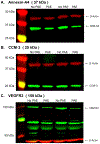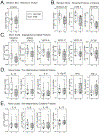The association between prenatal alcohol exposure and protein expression in human placenta
- PMID: 30891944
- PMCID: PMC6946025
- DOI: 10.1002/bdr2.1488
The association between prenatal alcohol exposure and protein expression in human placenta
Abstract
Background: The need for earlier recognition of children at risk for neurobehavioral problems associated with prenatal ethanol exposure (PAE) has prompted investigations of biomarkers prognostic for altered fetal development. Here, we examined whether PAE alters the expression of angiogenesis-related proteins and cytokines in human placenta in subjects from an Ethanol, Neurodevelopment, Infant and Child Health prospective cohort.
Methods: PAE was ascertained by screening questionnaires, Time-line Follow-back interviews and a panel of ethanol biomarkers at two study visits. After delivery, placental tissue samples were collected for protein analysis.
Results: No significant differences in the prevalence of substance use, demographic or medical characteristics were observed between the No PAE and PAE groups. PAE was associated with significant reductions in placental expression of VEGFR2 and annexin-A4, while the levels of VEGFR1 and CCM-3 trended downward. A trend toward higher expression of the cytokines TNF-α and IL-13 was also observed in the PAE group. Receiver operating characteristic analyses of the data demonstrated a moderate-to-high degree of diagnostic accuracy for individual placental proteins. Combinations of proteins substantially increased their ability to differentiate between PAE and No PAE subjects.
Conclusions: These results establish the feasibility of harvesting placental tissue for protein analyses of PAE in a prospective manner. In addition, given the importance of vascular remodeling in both placenta and developing brain, the role of angiogenic and cytokine proteins in this process warrants further investigation for their utility for predicting alterations in brain development, as well as their mechanistic role in PAE-induced pathology.
Keywords: angiogenesis; annexin-A4; cytokines; fetal alcohol spectrum disorder; placenta; prenatal alcohol exposure; vascular endothelial growth factor receptor 2.
© 2019 Wiley Periodicals, Inc.
Figures



Similar articles
-
Identifying Prenatal Alcohol Exposure and Children Affected by It: A Review of Biomarkers and Screening Tools.Alcohol Res. 2023 May 25;43(1):03. doi: 10.35946/arcr.v43.1.03. eCollection 2023. Alcohol Res. 2023. PMID: 37260694 Free PMC article. Review.
-
Effects of prenatal opioid and alcohol exposures on immune and serotonin factors in human placenta.Exp Neurol. 2022 Jul;353:114057. doi: 10.1016/j.expneurol.2022.114057. Epub 2022 Mar 29. Exp Neurol. 2022. PMID: 35364108 Free PMC article.
-
Ethanol-Induced Alterations in Placental and Fetal Cerebrocortical Annexin-A4 and Cerebral Cavernous Malformation Protein 3 Are Associated With Reductions in Fetal Cortical VEGF Receptor Binding and Microvascular Density.Front Neurosci. 2020 Jun 3;14:519. doi: 10.3389/fnins.2020.00519. eCollection 2020. Front Neurosci. 2020. PMID: 32655346 Free PMC article.
-
Prenatal alcohol exposure and prenatal stress differentially alter glucocorticoid signaling in the placenta and fetal brain.Neuroscience. 2017 Feb 7;342:167-179. doi: 10.1016/j.neuroscience.2015.08.058. Epub 2015 Sep 2. Neuroscience. 2017. PMID: 26342748 Free PMC article.
-
Potential roles of imprinted genes in the teratogenic effects of alcohol on the placenta, somatic growth, and the developing brain.Exp Neurol. 2022 Jan;347:113919. doi: 10.1016/j.expneurol.2021.113919. Epub 2021 Nov 6. Exp Neurol. 2022. PMID: 34752786 Review.
Cited by
-
Identifying Prenatal Alcohol Exposure and Children Affected by It: A Review of Biomarkers and Screening Tools.Alcohol Res. 2023 May 25;43(1):03. doi: 10.35946/arcr.v43.1.03. eCollection 2023. Alcohol Res. 2023. PMID: 37260694 Free PMC article. Review.
-
Prenatal Alcohol Exposure and Transient Systemic Hypoxia-Ischemia Result in Subtle Alterations in Dendritic Complexity in Medial Frontal Cortical Neurons in Juvenile and Young Adult Rat Offspring in a Pilot Study.Cells. 2024 Nov 30;13(23):1983. doi: 10.3390/cells13231983. Cells. 2024. PMID: 39682731 Free PMC article.
-
Single-cell RNA sequencing reveals placental response under environmental stress.Nat Commun. 2024 Aug 2;15(1):6549. doi: 10.1038/s41467-024-50914-9. Nat Commun. 2024. PMID: 39095385 Free PMC article.
-
Future Horizons for Neurodevelopmental Disorders: Placental Mechanisms.Front Pediatr. 2021 Apr 8;9:653230. doi: 10.3389/fped.2021.653230. eCollection 2021. Front Pediatr. 2021. PMID: 33898362 Free PMC article. No abstract available.
-
Effects of prenatal opioid and alcohol exposures on immune and serotonin factors in human placenta.Exp Neurol. 2022 Jul;353:114057. doi: 10.1016/j.expneurol.2022.114057. Epub 2022 Mar 29. Exp Neurol. 2022. PMID: 35364108 Free PMC article.
References
Publication types
MeSH terms
Substances
Grants and funding
LinkOut - more resources
Full Text Sources
Medical

